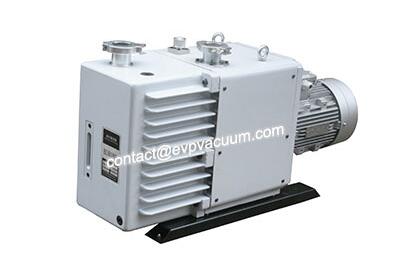Vacuum Pump in CVD Process
Usually when we choose the vacuum pump, we usually choose the type of vacuum pump according to the vacuum degree needed in the actual working condition, and choose the pumping speed of the vacuum pump according to the pumping volume. Of course, there are other factors affecting the application of vacuum pumps, such as the cleanliness of the process environment, the actual process and the reactant gases and particles in the pump.
Vacuum pumps are widely used in two fields: semiconductor and LCD manufacturing. The occasions used for non-reactive gas extraction are: upper and lower discharge chamber, transfer chamber, liquid crystal injection, Color Filter, etc. The occasions used for reactive gas extraction are ion implantation, etching, polishing, LPCVD, PECVD, etc. In CVD production, vacuum pump is required to extract reaction products and cleaning gases such as NF3, C2F6 and HCl.
Vacuum pump in general process:
(1) The purpose of N2 cleaning is to dilute the reactive gas inside the vacuum pump, provide seal for the pump shaft, and prevent the air and moisture from seeping into the exhaust port of the vacuum pump. N: The amount of clean gas can be adjusted according to the need.
(2) The cold trap with cold trap is usually installed at the suction and exhaust ports of the vacuum pump. The purpose is to reduce the amount of reaction products infiltrating into the pump, reduce the burden of the vacuum pump, and reduce the burden of waste gas treatment.
(3) Temperature control according to the different reaction products in the process, in order to prevent them from adhering to the pump, heating the exhaust port of oil-free machinery vacuum, or implementing temperature control on the upper pump.
(4) Ammonium chloride (NH4Cl), a by-product, can be produced in the process of on-line cleaning of chlorinated membranes prepared by LPCVD. Ammonium chloride can dissolve in water. Using this characteristic, the single-stage vertical oil-free mechanical vacuum pump can be cleaned automatically on-line, and the washing liquid can be used for cleaning without dismantling the pump from the production line.
Vacuum Pump in CVD Process
When LPCVD process is used to prepare insulating film or semiconductor membrane, the raw material of organosilane system (TEOS) is in liquid state, TEOS is mixed with reaction by-products, forming gel like and plugging the vacuum pump exhaust port, then the cold vent should be added to the exhaust port.
When insulating film is prepared by PECVD process, the by-product of TEOS reaction passes through vacuum pump in white powder form, so non-contact vacuum pump should be selected. Cleaning gas uses NF3, C2F6 and other by-products to combine with the above reaction, and then form another by-product, which has a negative impact on the vacuum pump. At this time, the method of reducing the temperature of the vacuum pump can be used to solve the problem.
Vacuum Pump Dry Etching Technology
Etching process can be divided into aluminium metal etching, polycrystalline silicon etching, oxide film etching, etc. Metal etching will produce a large number of reaction by-products, the vacuum pump load will be very large.
The etching of polycrystalline silicon film and silicon oxide film makes SF6 and other gases less by-products and lower sublimation temperature, which can be discharged out of the pump in a gaseous form. Aluminum metals are etched with chlorinated gases such as boron trichloride, which can produce a large amount of aluminum tetrachloride. The sublimation temperature is high, and it is easy to adhere to the parts with low temperature. The unreacted gases are mostly corrosive. Fluoride gas is often used in Qin etching, and its characteristics are similar to chlorine gas.
In the production of titanium etching, corrosive gases such as fluorine, chlorine and decarbonization are often used. These gases combine with water to form strong acid and have strong corrosiveness. Therefore, oil-free vacuum pumps and pipeline materials are required to have high corrosion resistance.
2XZ Direct Drive Rotary Vane Vacuum Pump
| Models | 2XZ -2C | 2XZ-4C | 2XZ-6C | 2XZ-8C | 2XZ-15C | 2XZ-25C | ||
| Pump speed | 50HZ (L/s) | 2 | 4 | 6 | 8 | 15 | 25 | |
| 60HZ (L/s) | 2.4 | 4.8 | 7.2 | 9.6 | 18 | 30 | ||
| 50HZ (m3/h) | 7.2 | 14 | 22 | 29 | 54 | 90 | ||
| 60HZ (m3/h) | 8.6 | 17 | 25 | 35 | 65 | 108 | ||
| Ultimate pressure(Pa) | Partial pressure | 6×10ˉ² | 6×10ˉ² | 5×10ˉ² | 5×10ˉ² | 5×10ˉ² | 5×10ˉ² | |
| Total pressure | 1 | 1 | 1 | 1 | 1 | 1 | ||
| Rotary speed(r/min) | 50HZ | 1400 | 1400 | 1400 | 1400 | 1400 | 1400 | |
| 60HZ | 1720 | 1720 | 1720 | 1720 | 1720 | 1720 | ||
| Motor power(Kw) | 0.37 | 0.55 | 0.75 | 1.1 | 1.5 | 3.0 | ||
| Working voltage(v) | 220/380 | 220/380 | 380 | 380 | 380 | 380 | ||
| InletDiam(mm) | I.D. | KF-25 | KF-25 | KF-25 | KF-40 | KF-40 | KF-40 | |
| O.D. | ||||||||
| Dimensions(mm) | Length | 480 | 520 | 545 | 616 | 705 | 830 | |
| Width | 150 | 150 | 172 | 255 | 255 | 275 | ||
| Height | 200 | 200 | 285 | 360 | 360 | 440 | ||
| Noise(dBA) | 65 | 65 | 68 | 70 | 70 | 72 | ||
| Oil capacity (L) | 0.8 | 1 | 1.5 | 3 | 3.5 | 4 | ||
| G.W./N.W. (kg) | 22/20 | 26/22 | 55/46 | 70/60 | 86/75 | 105/85 | ||


